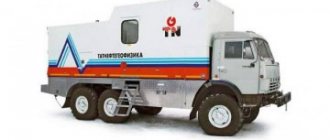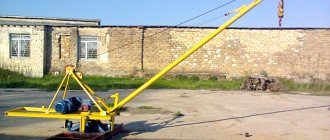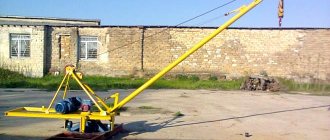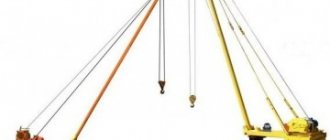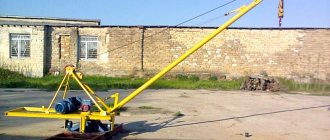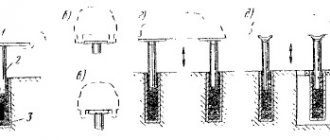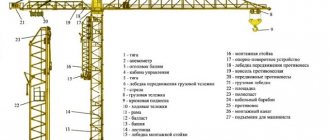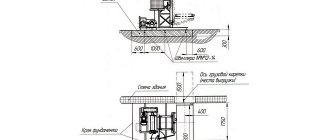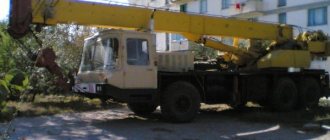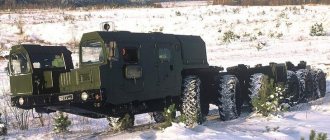Homemade crane for building a house
Almost any construction site cannot be done without special equipment, especially a construction crane.
It becomes an indispensable assistant when it is necessary to lift heavy loads to different heights. Most people associate this technology with huge size, but there are many types of faucets that are ergonomic and compact.
You can even do some options yourself, saving personal savings during construction. In this article we will look at how to assemble a homemade Pioneer crane for building a house.
Mini construction crane: scope of application
Mini cranes are in great demand. They are used during construction and repair work. Modern manufacturers offer innovative solutions in the manufacture of their products.
These devices are different:
- maneuverability;
- wide range of applications;
- functionality;
- ease of use.
Thanks to the presence of various attachments, various manipulations can be carried out with this technique.
Mini cranes, both purchased and assembled at home, are capable of working in the most difficult to reach places: in cramped courtyards, dense urban construction, uneven sites, inside buildings and on roofs. Compact dimensions allow special equipment to even pass through single or double doors.
They are often used for fine, almost jewelry work. Manufacturers of modern technology conducted an experiment with a matchbox that had to be moved from one place to another. At the same time, the device did not crush or crush a cardboard box of such a tiny size.
The presence of a control panel for the units allows users to control the work process while standing next to the equipment near the load, but only purchased units assembled in production have such advantages.
You are unlikely to be able to make such a device yourself. But you can try to build something similar. Of course, a mini crane assembled by yourself will not be very functional, but it will be able to lift loads of a certain mass to a specified height.
Design Features
Pioneer cranes (in common parlance - KP) are boom lifting and transport devices that are controlled directly from the ground or from the conditional zero level of lifting the load. Due to their compactness and low weight, such devices can be installed even on the floors of already constructed floors. At the same time, the gearboxes differ in completely operational technical characteristics. For example, they can lift loads weighing 500 kg, 750 kg and 1000 kg to a height of 4.5...6 m (if the crane is installed on the ground) to 50 m if the crane is installed on the roof of a facility under construction.
The components of the Pioneer crane include:
- The support frame is rectangular in shape.
- Four wheels for moving the structure on a flat and stable base (the slightest slope is unacceptable). KP and stationary types are produced.
- A vertical load axle equipped with bearings and rigidly attached to the support frame.
- A rotating platform that rotates freely in bearing units.
- A load boom that can have a fixed or adjustable length.
- Concrete counterweight (on Pioneer cranes with a lifting capacity of 750 and 1000 kg, two symmetrically located counterweights are installed).
- Main hook suspension.
- Safety harness with support ties.
- Cargo winch.
- Boom stop unit.
- Load rope.
- Control units: travel and limit switches, push-button station.
To install the control panel, it is enough to have a free platform (in the wheeled version - concrete or asphalt) with dimensions of no more than 5x2 m and with a free area at the top of at least 4500 mm. The structure can be easily disassembled and quickly reinstalled at a new place of work. The Pioneer crane weighs (with ropes and hook), depending on its lifting capacity, from 900 to 1800 kg.
Simple mini-faucet with your own hands
If you make a mini crane with your own hands, it will be able to lift loads weighing up to 250 kg. This will greatly simplify the construction process on site. It can handle lifting logs, concrete mortar, and roofing materials. With it, you can do construction yourself without involving a large number of workers.
The main thing when making a mini crane is to prepare a drawing, the necessary tools and parts. The weight of this structure can reach 300 kg. It depends on what materials you will use during assembly. Despite its impressive weight, the mini crane will be distinguished by its compact size and high performance.
Assembling a mini crane with your own hands consists of the following steps:
- Using a gearbox, a cargo winch is attached to a worm base.
- Construction supports are the basis for screw outrigger systems.
- In addition to the basic structure, drums for winches will be required to assemble the unit. Making them on your own is quite problematic. Therefore, it is recommended to purchase ready-made products.
- Rotors from an electric motor can be used as a basis.
Attention: when assembling a mini crane yourself, special attention must be paid to the ratio of the sizes of the elements and the dimensions of the future device.
To make the device convenient to use, its platform can be equipped with wheels. This is where the old transport cart comes to the rescue.
Features of mini cranes assembled by yourself include:
- The optimal boom height is 5 meters. To make it yourself, you will need to use a pipe with a diameter of 8 cm.
- A profile of 2 corners is mounted on the base and a rotating mechanism is created to rotate the boom. An automobile hub from a truck is suitable as a turning mechanism.
- To build a counterweight, you don’t need any special materials. Ordinary bricks can serve as them.
Specifications
Technical characteristics of Pioneer lifts are presented in the table:
| Characteristics | Unit measurements | KP 500 | KP 750 | KP 1000 |
| Boom extension | m | 2,5 | 2,5 | from 2.5 to 4 |
| Load capacity at boom extension 2.5 m | T | 0,5 | 0,75 | 1 |
| Load capacity at boom extension 3 m | T | — | — | 0,8 |
| Load capacity at boom extension 4 m | T | — | — | 0,5 |
| Lifting height at boom extension 2.5 m | m | 4,5 | 4,5 | 6,2 |
| Lifting height at boom extension 3 m | m | — | — | 6 |
| Lifting height at boom extension 4 m | m | — | — | 5,3 |
| Lifting height (from floor) | m | up to 50 | up to 45 | up to 50 |
| Working speed | m/min | 16,8 | 8,4 | 11,8 |
| Platform rotation amount | degree | 360 | ||
| Electric drive power | W | 4000 | 4000 | 4750 |
| Lifting mechanism | electric | |||
| Mains voltage | IN | 380 | ||
| Rotary mechanism type | manual | electric | ||
| Number of counterweights | PC. | 9 | 9 | 15 |
| Weight (total) | T | 1,345 | 1,355 | 1,82 |
| Rope thickness | cm | 0,69 | 0,69 | 0,78 |
| Dimensions | m | 4.2x1.7x5.4 | 4.2x2.0x5.4 | 6.1x2.14x6.5 |
| Width (transport) | m | 1,77 | 2,18 | 2,135 |
| Length (transport) | m | 2,45 | 2,67 | 2,85 |
| Height (transport) | m | 1,325 | 1,35 | 1,6 |
| Boom type | L-5200 | L-5200 | L-6450 | |
| Boom thickness | cm | 10,2 | 10,2 | 13,3 |
The video shows the Pioneer lift in action:
Types of manual taps
All construction cranes are classified into:
- self-propelled;
- stationary;
- tower;
- special purpose.
This equipment is equipped with a boom extension mechanism, a cargo trolley, and a rotating support.
By type of movement they are divided into:
- stationary;
- adjustable;
- self-elevating;
- mobile.
According to the type of control, these devices are electrically driven and manual (mechanical).
Pioneer-750
The Pioneer-750 crane has technical indicators similar to the 500th model.
- the mass of transported cargo is increased to 750 kg;
- lifting speed - 8.4 m/min;
- moving height - 45 m;
- manual rotation - using a special lever;
- load lifting mechanism - AIR100L4EU3 electric motor with a rated power of 4 kW and a rotation speed of 1410 rpm on 3-phase alternating current;
- control is carried out by a 220 V remote control;
- most units are made stationary, the booms are non-removable with a reach of 4.5 m;
- dimensions - 4.2x2.0x5.4 m;
- transport width - 2.18 m;
- transport length - 2.67 m;
- height - 1.35 m;
- weight - 1355 kg.
Lift
Modern lifts are divided by type into:
- Foot. They are capable of lifting heavy loads weighing up to 2 tons to a height of 8 meters.
- Telescopic. Their advantages include: light weight and compactness. These devices are capable of lifting loads to a working height of up to 150 kg.
They, in turn, are divided into:
When choosing a lift, it is worth considering several factors: their dimensions, load capacity, scope of application.
To make a lift yourself, prepare materials and a preliminary drawing. To build it we will need:
- a winch, which can be made from a drum and a cable;
- pipes;
- electric drive
The advantages of construction hoists include:
- maneuverability;
- high load capacity;
- safety;
- ease of use.
Pioneer-2000
The Pioneer-2000 crane is an improved version of the KP-1000 lift. After upgrading the model, the liftable load can reach 2 tons. This module is manufactured by the manufacturer to special order and is in demand in the construction of facade structures, when installing windows and sandwich panels.
- equipped with electromagnetic hydraulic brake;
- electric drive for boom rotation;
- gearbox, power unit and winch with a 4-fold safety margin.
Taking into account the console reach, the maximum lifting capacity with double reeving of the rope is:
- with a reach of 4.6 m - 1500 kg;
- 4.4 m - 1700 kg;
- 4.1 m - 2000 kg.
Maximum lifting height of the hook mechanism:
- at reach 4.6 m - 4.3 m;
- 4.3 m - 4.5 m;
- 4.1 m - 4.65 m.
The maximum depth of lowering the hook is 100 m with a double safety margin of the rope.
Unit operating speed:
- with single reeving - 5.6 m/min;
- at double speed - 11.3 m/min.
The rotating part moves 360° around the axis. The turning radius reaches 3 m.
Structural weight - 1.5 tons.
Scissor crane
The scissor crane is a simple and easy-to-use design. Due to their versatility and functionality, these devices are used in installation and construction work. They can also often be found in supermarkets and warehouses.
A scissor crane lifts tons of loads every day. This technique, in addition to the construction industry, is regularly used in the maintenance of advertising billboards, facade signs, and elevators.
Their main advantages include:
- performance;
- high load capacity;
- compact dimensions when folded;
- wide range of applications;
- maneuverability.
Their advantages also include autonomy - they can operate on batteries. In addition, cranes can be equipped with different types of drives:
- electrohydraulic;
- diesel;
- electrical;
- hydraulic.
Most often, models with electric drives are used in construction. They are affordable, environmentally friendly and easy to use.
There are a large number of variations of devices of this type, but almost all of them consist of:
- lifting device,
- mobile platform;
- equal-speed drive wheels.
To build a scissor crane yourself, you will need to make the base and platform of the apparatus from a channel. To make scissors you will need:
- two-section distributor;
- bushings;
- pump;
- hydraulic cylinder;
- I-beams.
A DIY scissor crane is capable of lifting loads weighing up to half a ton. This device is installed on the UAZ, and after operation it is removed. The basis of the structure will be a thick square bolted to the frame, and the retractable pores will be held on the car bumper.
Pioneer-1000
The Pioneer-1000 jib crane is an advanced multifunctional equipment with a lifting capacity of 1000 kg. The turning and lifting mechanisms are powered by a 380 V electrical network and a driving power of 4.75 kW, making operation quick and easy.
The arrow is produced in 3 versions:
- with a reach of 2.5 m;
- 3m;
- 4 m.
As the length increases, the load capacity and lifting height decrease:
- the boom, designed for a reach of 2 m, moves loads weighing up to 1 ton to a height of 6.2 m;
- at 3 m - up to 0.8 t at a height of 6 m;
- at 4 m - up to 500 kg at 5.3 m;
- for ground mounting - 6 m.
Fixation is done using ties.
Console units are available in 2 versions:
- adjustable;
- mobile on wheels.
On the rotating platform of a stationary lift, special stops are installed that regulate the angle of inclination and protect against tilting.
In a mobile crane, manufacturers construct rails from channels along which movement occurs.
The working speed reaches 11.8 m/min.
In comparison with the Pioneer-500, in which counterweights are hung, in the tonnage counterweights in the amount of 15 pieces of 48 kg each are located in a specially equipped box.
Technical characteristics of KP-1000:
- overall dimensions when assembled - 6100x2140x6500 mm;
- weight without counterweights - 1070 kg;
- total weight - 1820 kg;
- chassis with a rotating frame - 2850x2130x1600 mm;
- boom - 6.45 m.
Crane Pioneer
The Pioneer type lift has excellent technical characteristics. It is light in weight and distinguished by maneuverability and mobility. The advantages of this device include the ability to quickly and easily assemble and disassemble.
To deliver the device to the construction site, it can be disassembled and folded into a simple gazelle. After work, it can also be easily disassembled and transported back. The crane can be installed anywhere: on the ground, in a pit, on a roof, on building floors.
This special equipment is produced by different companies in three main modifications of cranes, lifting capacity, and booms.
If necessary, you can make a Pioneer crane on your own, having with you the necessary consumables, tools, a well-drawn drawing and free time.
As for the scope of application of the Pioneer, it can be used to move various objects in any weather conditions. It is capable of delivering cargo to any floor or building structure. With its help you can deliver: tools, equipment, building materials and the like.
Quite often this device is used when installing roofs. With it you can quickly lift various loads, machines, metal structures, and materials.
Pioneer-500
The Pioneer-500 crane is a device for lifting loads up to 500 kg, which is installed both on the roof or ceiling and on the ground. When carrying out work on the roof, the maximum lifting height can reach 50 m, at ground level - up to 4.5 m. To repair flat roofing surfaces, the mechanism is lifted, installed and connected to an electrical network with a voltage of 220 V, 50 Hz via a flexible cable. For low-level work there is the possibility of attaching to the ground zero point.
The load is gradually lifted at a speed of 16.8 m/min, the platform rotates 360° with a rotating boom, moving the material to the desired location. The turning mechanism is manual, while the process is controlled, the lifting mechanism is electric.
The length of the solid boom for Pioneer-500 is 5200 mm, diameter - 102 mm. The dismountable device consists of 2 parts, each 2700 mm long, connected by bolts.
The chassis with a rotating frame has the following transport dimensions:
- length - 2450 mm;
- width - 1770 mm;
- height - 1325 mm.
Dimensional and weight characteristics of the crane:
- length - 4200 mm;
- width - 1700 mm;
- height - 5400 mm;
- weight without counterweight - 395 kg;
- total weight - 830 kg.
The mini crane can be easily dismantled, disassembled, moved manually to another place, assembled and re-installed.
Mini crane for building a house by one person. Drawings, videos and descriptions
When building a house, it is necessary to lift building materials: onto the walls, onto the second floor, and beams for the roof. When you do everything alone, you have to solve these issues. Some people use a truck crane or a truck crane. But it is expensive to constantly bear such costs.
What if you decide to build a house from timber? And not from 150x150 mm, but with a cross-section of 180 mm! This is not possible for one without an assistant or mechanization.
Let's look at the designs of self-builders and professional teams who use mini-cranes with electric hoists at their sites.
Construction of a log house using a mini crane with a comfortable grip. No slings needed. The height of the crane allows the construction of a full floor. But this design is material-intensive, as you can see. Large volume of pipe used
There are simpler options when a mini-crane is attached to the wall of a building (or to the foundation at the initial stage of construction)
Another mini-crane with attachment to the foundation or log house. Allows you to lift beams with a maximum weight of 80 kg. A Denzel 125 kg electric hoist was used.
Mini crane drawing. Boom rotation – 360 degrees.
Another very compact and mobile mini-crane design. This crane can be transported from site to site (for those who work in a team) inside a car:
The beam is installed vertically and secured as a mast. And a boom structure with an electric hoist is attached to it
Fastening the timber (mast) to the wall. When there are no walls yet, the mast will have to be mounted on diagonal supports from beams.
Device for fixing and gripping timber. But you can use regular slings.
I agree with the opinion of the author of this homemade product. The most optimal and less material-intensive structures will be those with electric hoists that are attached to vertical masts, beams, and walls:
The design is simple, you can make it yourself if you have the necessary tools: an angle grinder, a welding machine. Fix to a mast made of bursa or two twisted beams.
Schemes and drawings of such a crane
There is a large selection of electric hoists on sale for different lifting weights and with different mounting options: stationary or on casters.
My neighbor in our village did not build a crane. He dragged the beam along an inclined plane (two other beams) with such an electric hoist. I simply screwed it to the wall of the building.
At one time, when building a bathhouse from timber, I didn’t invent anything, but hired a student to work in the evenings and on weekends. It cost me less than buying an electric hoist and building a crane. But the height was also small.
Video describing the manufacture of a mini crane
Photo taken from open sources, from the Yandex.Images service
Subscribe
to the channel, bookmark it in your browser. There is a lot of interesting information ahead.
Making a faucet with your own hands
Any user of forumhouse.ru will agree with the statement that one of the most necessary equipment during construction is a crane.
The steel hero becomes an indispensable assistant when the need arises to lift a large load. A lifting mechanism is usually associated with a huge structure tens of meters high. However, in private house-building, when compact mechanisms for construction come to the fore, one needs an option with a boom length not exceeding 5-7 meters.
But renting it is not a cheap pleasure, especially if the construction lasts for more than one month.
In this case, there is only one way out - roll up your sleeves and build a homemade mini-crane with your own hands. And our forum members will help you with this!
see also
Comments 7
Now I understand where the rule came from - “Do not stand under the load and arrow”)))
It wouldn’t be a bad idea to transport a walk-behind tractor with a trailer. So my bro made a cart for his walk-behind tractor like this: the beam under the cart is from the nine, and in front of the walk-behind tractor he made counterweights from lead, and took the lead from batteries.
In this well there was a displacement of the rings. I dug a hole 6.5 meters deep all around, put the rings and buried it back. Now almost all the clay has been removed. I moved the crane to the pile and used a barrel with an axle at the center of gravity. I didn't carry the clay, I just poured it out. Then, when burying, I had to, yes, ride on a cart, but it wasn’t far. Just 7-8 meters.
I don't have a walk-behind tractor. I have an electric cultivator, which has been serving faithfully since 1992. This is the equipment of our Tula Design Bureau. Now the Nadezhda cultivator is being produced based on it. He comes with a plastic case, and I have a metal one.
I don’t even want to buy new equipment (such as a walk-behind tractor). She's very brittle. The Oleo-Mac lawnmower with a Briggs-Stratton engine died in its 4th year. Karcher K 5.600 is now moping. I got depressed after the winter. The Oleo-Mac brush cutter also seems to be working, but the lugs for attaching the gas tank have fallen off on the crankcase. We have to farm plates, which often break off due to vibration.
In short, I didn’t think about it anymore. Is it worth buying such equipment? The cultivator has been working here for 23 years. And the mower died after 4. How?!
well how how? dashing of course :-) I’m not arguing about walk-behind tractors. Right now the technology is no longer of the same quality. there, the bro had almost nothing left from the purchased one, he almost completely redid it and got a motorcycle terminator that can carry 5 people in a cart, carry large loads and climb in and out of mud holes :-))
DIY crane
Throughout the long history of its existence, man has more than once been faced with the task of lifting and moving heavy objects in space. For example, the familiar Egyptian pyramids consist of massive stone blocks that no one can lift. Therefore, one of the greatest achievements of mankind is the invention of the lifting crane, which made it possible to significantly simplify the task of moving heavy loads and speed up the construction of houses and other objects.
terms of Use
To operate lifting mechanisms safely, certain rules must be followed.
Homemade Pioneer crane
These rules apply to any lifting device:
- The load capacity must not be exceeded. A load that is too heavy may damage the device.
- The base must be stable. Homemade lifting devices should be located on a previously prepared hard horizontal surface.
- In bad weather conditions, you should also refrain from working with the crane. Strong winds will throw the crane off balance, and poor visibility may make it difficult to see people under the boom.
- Before operating a crane or lifting device, it is necessary to conduct an external inspection to identify any malfunctions. If malfunctions are detected, operation of the crane is prohibited.
- It should be remembered that when working with the lift, you should not make sudden movements. The load must be lifted smoothly. And most importantly, do not stand under any lifted load.
What characteristics should a garage lift have?
In garage conditions, two types of lifting mechanisms are used. The first type includes a lift that can lift the entire car, and the second type includes a goose-type lift that allows you to move loads around the garage.
Lifts of the first type are stationary devices and the main requirement for them is stability. The car weighs more than a ton and should not have the slightest chance of falling. In order to prevent any accidents, the garage lift must have a reliable stopper.
Homemade goose tap
The goose type lifts are most often used in auto repair shops. It is quite simple to make it from a profile pipe or channel. First, the base is welded on which the rotating mechanism needs to be installed. It is best to make an arrow with an adjustable reach. This will make it possible to move weights in any direction.
How a simple block design works
The pulley system or pulley system has been known to mankind since ancient times. The classic system design consists of pulleys and cable. One pulley is called a block. Depending on the method of fastening, the pulley can be movable or fixed:
- Fixed block. It is attached to the support and plays the role of changing the direction of movement of the rope. Does not provide any gain in strength.
- Movable block. It is located on the side of the load and gives a gain in strength.
The principle of operation of a pulley block is similar to the principle of operation of a lever in the physics of simple mechanisms. The role of the lever in this case is played by the cable itself. In the case of a simple block of two pulleys, the movable pulley divides the rope into 2 parts and in order to lift the load the same distance, a rope twice as long will be required. The work of lifting the load is performed in the same volume. And the effort, due to the fact that the length of the rope has become twice as long, becomes half as much.
If there are more than 2 pulleys in the system, the gain in strength is approximately equal to the number of blocks. In the case of 3 blocks, the effort will be 3 times less, and 4 blocks will require only a quarter of the original effort.
Design and principle of operation
The crane is a collapsible structure, installed at different construction sites with a permissible slope of no more than 3°. The mechanism is manufactured in several modifications in accordance with GOST 1451-77.
The main assemblies of the lift:
- rotating frame with drive;
- running frame;
- arrow;
- hook suspension;
- final stop mechanism;
- screed;
- cargo rope;
- counterweight;
- load;
- safety rope;
- travel switch;
- winch;
- electrical equipment.
The running frame can be stationary or wheeled.
The boom is made in a collapsible design or in one piece. The thickness of the arrow is no more than 10.2-13.3 cm. The length does not exceed 3.5 m.
Rope thickness - 0.69-0.78 cm.
The minimum counterweight weight is 750 kg.
Depending on the load capacity, the crane can be rotated in 2 ways:
The winch is driven by an electric drive with a power of 4-4.75 kW, operating from a network with a voltage of 380 V. The mechanism raises and lowers the load to a height of 4.5-6.2 m with a boom extension of 250 cm at a speed of 8.4-16 .8 m/s. The crane platform rotates around its own axis. In some cases, a special platform cradle is installed.
The control process is carried out by the operator using a remote push-button remote control.
Pioneer lifting mechanisms are divided into 3 types based on maximum load:
All other characteristics depend on the carrying capacity.
Complex block system how to calculate power gain
If the system is designed in such a way that one simple pulley pulls another simple pulley, then this is already a complex system of blocks. To theoretically calculate the gain in strength, it is necessary to conditionally divide a complex chain hoist into simple ones and multiply the values of the gain from simple chain hoists.
For example, if the system consists of 4 blocks, and the first conditional simple pulley has a gain of 3. It pulls the second simple two-block pulley, also with a gain of 3. The total force that will need to be applied will be 9 times less. It is the 4-block complex chain hoist that is most often used by rescuers.
Methods for attaching a rope to a lifting mechanism
When creating complex pulley blocks, there are often situations when a cable of the required length for attaching the moving block is not at hand.
Crane for gas blocks
Methods for attaching a cable using general-purpose rigging:
- Using a cord. Using a self-tightening knot, the cord is tied to the main cable. As the load is lifted, the grappling knot moves along the main rope, thereby allowing the height of the load to be increased.
- Using clamps. In the case of using a steel cable, it is not possible to use a cord, so it is necessary to use special clamps.
We create a simple lifting mechanism with our own hands
Construction of a crane is not a quick task and is justified if it is required frequently or the volume of work is large enough. In cases where the load needs to be lifted urgently or this is a one-time operation, you can use improvised means.
To create a simple lifting device you will need a cord and two blocks. One block and the end of the rope are fixed motionless on the support. This will be the highest point to which the load can be lifted. We attach the second block to the load using slings or a hook. We first pull the rope along the block attached to the load, then pass it through the upper block. The gain in power will be 2 times. Using your own weight, you can easily lift a load weighing 100 kilograms to the required height.
DIY mini crane
If you add the ability to move the upper block along a guide, for example along a rail, you can get a do-it-yourself jib crane. It is useful in garage conditions for moving heavy machine parts.
It should be remembered that when working with the lift, you should not make sudden movements. The load must be lifted smoothly. And most importantly, do not stand under any lifted load. The same rule applies to a crane - standing under the arrow is prohibited.
turbomotor412 › Blog › Homemade pioneer crane part 3 demonstration of work
Does everyone remember that I made a crane?
For those who don't remember the links: Part 1 Part 2
Well, now, as Gagarin said, “Let's go!”
I made the crane to dig a well. The well is not the usual difficult case here. To avoid asking questions and why the hell not, read part 1, or watch the video below.
The first test drive of the crane showed that it was quite functional, but at the end of the day the boom began to twist to the side - the welding was torn off. Well, what's the problem? XHeeeeh.
All you need to solve the problem is reinforcement, a cable, 2 lanyards.
I made a tap for a barrel, but turning it over is not so convenient, although the axis is located approximately at the center of gravity. And it weighs a hell of a lot - heavier than a car.
And then it dawned on me. Why pour it into a wheelbarrow every time, if you can lower the wheelbarrow itself into the hole. No sooner said than done. I welded 3 hooks to the wheelbarrow (a loop in front). The car is an old wreck - it had to be welded.
HOW DO YOU ACTUALLY LIVE WITHOUT A WELDING MACHINE?
Bottom line - see for yourself, check out the load capacity at the same time
Well, something like this. Now watch the video. It was inconvenient to remove with one hand and operate the tap with the other, so sorry.
Well, now just a review of the design for a snack.
Materials and tools
The most important thing when making a crane is to use high-quality tools and materials. This will guarantee that the structure will be strong and safe.
The cable should have minimal stretch; this will give a greater gain in strength when using a pulley system. The fittings used for tying must be taken only from metal. Plastic fittings cannot withstand heavy loads and break at the wrong time. To fasten individual parts of a homemade crane, you should choose high-strength hardware products.
If a winch is intended to be used, its lifting capacity should not be less than 500 kilograms. The best choice would be winches that can lift a load weighing 1 ton or more.
In conclusion, I would like to once again remind you of the need to observe safety precautions when working with lifting mechanisms. Also, regardless of whether the crane is purchased or made by yourself, you should inspect it before starting work.
